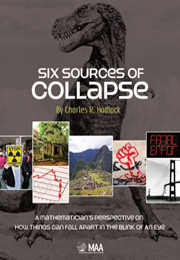 Six Sources of Collapse
Six Sources of Collapse Sharing an electric blanket and other challenges
I happen to have a lot of experience with electric blankets. It comes from owning that old unheated New Hampshire summer getaway I've mentioned earlier, and from making an occasional winter foray into it on snowshoes to see if it's still standing and to retrieve one or another forgotten item. The best way to survive the night there in freezing conditions (both inside and out) is to turn on an electric blanket several hours before getting into the bed and letting things warm up a bit. But invariably, when you get into the bed and lie there for a while, you find that some adjustment of the temperature control is needed. If it's too high, you wake up sweating to death, and if it's not high enough, you wake up wondering why you decided to torture yourself by staying overnight. With adjustments during a single night or a setting based on experience gained over several years, it's not too hard to find a “stable equilibrium setting that keeps things at or close to a comfortable, constant temperature. Fine so far.
The situation is slightly more complicated when my wife accompanies me as we prefer somewhat different temperature settings for the blanket. Thus there have been occasional middle-of-the-night adjustments by one or the other of us to suit our own tastes, hoping that the other person is sufficiently sound asleep not to notice.
To save this book to your Kindle, first ensure no-reply@cambridge.org is added to your Approved Personal Document E-mail List under your Personal Document Settings on the Manage Your Content and Devices page of your Amazon account. Then enter the ‘name’ part of your Kindle email address below. Find out more about saving to your Kindle.
Note you can select to save to either the @free.kindle.com or @kindle.com variations. ‘@free.kindle.com’ emails are free but can only be saved to your device when it is connected to wi-fi. ‘@kindle.com’ emails can be delivered even when you are not connected to wi-fi, but note that service fees apply.
Find out more about the Kindle Personal Document Service.
To save content items to your account, please confirm that you agree to abide by our usage policies. If this is the first time you use this feature, you will be asked to authorise Cambridge Core to connect with your account. Find out more about saving content to Dropbox.
To save content items to your account, please confirm that you agree to abide by our usage policies. If this is the first time you use this feature, you will be asked to authorise Cambridge Core to connect with your account. Find out more about saving content to Google Drive.